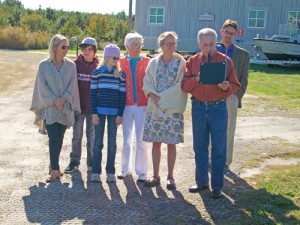
BERLIN — Family, friends and government officials were among those gathered for the dedication of Tom Patton Lane last Friday.
“I have no doubt he is a very, very pleased person today,” said Delegate Norm Conway (District 38B).
Stretching approximately half a mile, Tom Patton Lane serves as a connection between the greater Assateague area and the Rackliffe Plantation House, a restoration project he was dedicated to in recent years.
“We really try here to give visitors a seamless experience,” said Assateague National Seashore Superintendent Trish Kicklighter.
Kicklighter said that the lane will allow guests to make the transition from the beach and wildlife of Assateague to the historic Rackliffe Plantation House quickly and conveniently.
The goal of the Rackliffe House Trust, which Patton founded and led up to his death, is “to restore the former plantation house and turn it into a museum tracking the settlement of Maryland’s coastal bays.”
Patton, who was recognized with the Maryland Coastal Bays Program (MCBP) Golden Osprey Award in 2010, had a passion for the restoration of the house.
Originally owned by Patton’s ancestors, the Wale and Rackliffe families, restoration on the property began in 2004 with the Rackliffe House Trust raising hundreds of thousands of dollars to contribute to the project. More than 250 years old, Rackliffe stayed in the family for hundreds of years until it was eventually abandoned and subsequently purchased by the state.
When Patton decided to turn Rackliffe into a heritage museum, he was able to secure a 50-year lease for the building and the three acres around it.
Before Patton became involved, however, the site looked like it was falling apart.
“It was a derelict … but [Patton] had vision and he had perseverance,” said Jay Parker, a member of the Lower Eastern Shore Heritage Council.
Parker went on to congratulate Patton for a lifetime of historical preservation, not only with Rackliffe House but with Worcester County in general.
“Because Tom’s fingerprints are on a lot of things in this community,” he said. “He created not just monuments but living, breathing organizations.”
Several speakers who remembered Patton during the dedication used two words to describe him; visionary and gentleman.
“Quite frankly, I think we need to follow Tom’s example,” said Berlin Mayor Gee Williams.
Williams said that, despite Patton’s tenacity pursuing goals and projects, he never sacrificed his air of civility in any of his dealings.
“He was a visionary gentleman,” said Williams.
Kicklighter agreed, as did County Commission President Bud Church.
“He was a negotiator,” joked Church.
Many in attendance last week noted Patton’s work on projects outside of Rackliffe house.
His volunteer experience also includes work with the Maryland Historical Society, the Lower Eastern Shore Heritage Committee, St. Martin’s Church Preservation Foundation and with political advocacy and community association issues. He served on the board of the Assateague Coastal Trust.
After the speakers, Patton’s family was on hand to officially pull the curtain from the new Tom Patton lane street sign.
“Now you can drive down Tom Patton Lane to his vision for Rackliffe House,” said Jim Rapp, executive director of the Rackliffe House Trust and Delmarva Low-Impact Tourism Experiences.
